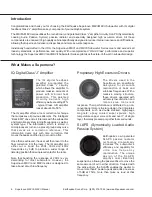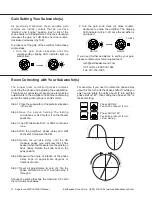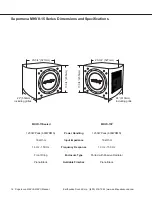
12
13
ou often hear the term “subwoofers are non-
Y
directional.” This is not true. It is harder to choose
subwoofer placement when low frequencies are
crossed. The wider the room, the more directional the
subwoofer. The easiest solution is to use two (2)
subwoofers, feed a mono signal to both and place
them in the front, one of the left and another on the
right.
While having two (2) subs is better than one, the
MONO signal that drives those subwoofers keeps
them from projecting the three dimensional images in
the sub-harmonics. Using two (2) subwoofers allows
you to cross the subs up to 150Hz sound quality,
imaging and staging. In some applications, you might
have small front speakers or planar speakers. The
two-front-subwoofer system is an excellent solution
to planar speakers’ low frequency response early roll
off from 150Hz on down. When placing these
subwoofers in a close proximity to the stereo satellite,
the subs will enhance low frequency extension. It will
be better to have a stereo subwoofer to help in the
lower bass notes and their placement.
Suppose you have only one (1) subwoofer in the
room and it is placed on the right side of the room. If a
bass guitar player was standing on the left side of the
stage and played an EE note (42Hz), then the sub will
also respond to that from the right side of the room
and completely destroy the stage.
To give you a three-dimensional front-end bass that
allows you to have a low frequency dynamic stage,
the IQ series amplifier used on the Supernova MKVI
& MKVII subwoofers was designed with dual input
circuits that use buffers to maintain your stereo
separation on the processor side, while mixing stereo
front signals to produce 3D bass.
On the next page, you will see illustrations showing
the three (3) different suggested setups. In each of
them, note the breakaway and the image separation
represented by the black and gray arrows. The best
response is achieved when the subharmonic
frequencies are dynamically synchronized with the
rest or the audio system, the black and gray arrows
are identical
The black arrows represent the
subharmonic frequencies.
The gray arrows represent the lows,
mids and highs as they follow the
action.
Specifications are subject to change without notice.
Supernova MKVI & MKVII Manual 9
PHASE SHIFT
This 0 - 180° phase shift switch allows the user
to flip the Supernova 180 degrees out of phase if
the sub is deemed to be out of phase with the
rest of the speakers. When set properly and with
the phase delay, out-of-phase side effects such
as loss of sound pressure and reduction in
overall system performance can be eliminated.
GAIN CONTROLS
These variable gain controls are infinite controls
that do not have “starting” and “ending” position.
Each click of the knob equals to 1dB adjustment.
One click clockwise increases the gain by 1dB
while one click counter-clockwise decreases by
1dB.Note that each input has its own
independent digital gain control: GAIN 1 &
GAIN 2. Both of those controls are internally
mixed so they feed one combined signal into the
amplifier. More on this feature can be found on
the “Gain Setting Your Subwoofer(s) section on
page 12.
CLIPPING LED INDICATORS
These yellow LEDs only light up when the input
is clipped. Simply rotate the corresponding gain
control knob three (3) clicks counter-clockwise
to unclip the input and create a 3dB headroom
(play).
INPUT SELECTIONS
There are two sets of inputs, each accepts three
(3) input types: RCA, XLR and SPK (speaker
level).
INPUT 1 is a dedicated stereo signal input. For
example, if the system has 2 subwoofers, feed
the left channel to the INPUT 1 of the left
subwoofer and feed the right channel to the
INPUT 1 of the right subwoofer.
INPUT 2 is a dedicated LFE input, designed to
accept low frequency/low pass (already
crossed) signal from the processor or receiver.
Placing Your Subwoofer(s)
10
11






































